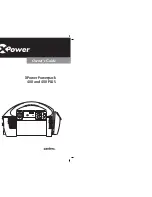
Jigsaw EN
10
be moved to improve access for cleaning,
blade fitting, etc (See Fig. C).
6. BLADE FITTING
You can only use the blade type shown in Fig
D. To open the blade holder (11) rotate the ring
clockwise (Jigsaw upside down) and hold in
position (See Fig. E). Then fully insert the blade
into the blade holder slot with blade teeth
facing forward and release the ring, which will
self rotate and clamp over the top of the blade.
Push the blade into the blade holder again to
ensure it is locked in position. Ensure the edge
of the blade is located in the groove of the
blade guide (See Fig. F). To remove a blade,
holds the blade and rotate the blade holder
ring clockwise then lift out the blade (blade
could be spring ejected).
WARNING: Blade teeth are very
sharp.
For best cutting results ensure
you use a blade suited to the material and cut
quality you need.
7. PARALLEL GUIDE FIXTURES
Slide the parallel guide (7) arm through
both fixtures to achieve the required cutting
distance and tighten both screws to lock into
position.
8. ROLLER GUIDE
Ensure the blade is located and runs smoothly
in the groove (See Fig. F) otherwise the
pendulum function will not work correctly and
the blade will not be supported during cutting.
9. PENDULUM ACTION CONTROL
The pendulum action varies the forward
cutting angle of the blade for increased cutting
efficiency. This can also be adjusted during
no load running. Refer to the chart 2 for more
details. Do not use excessive blade force when
cutting with the pendulum action. The blade
cuts on the upward stroke only (See Fig. G).
Chart 2
0
Thin materials. Fine cuts. Tight curves.
I
Hard materials, (e.g. steel & chipboard)
II
Thick materials (e.g. wood) & plastic
III
Fast cuts (e.g. softwood). Cutting in the
direction of the wood grain.
10. BASE PLATE
Adjusting the angle of the base plate (13)
enables bevel cutting. The base plate must
always be held firmly against the materials
being cut to reduce saw vibration, blade
jumping or blade breakage.
11. PLASTIC FOOT PLATE PROTECTION
Your tool is equipped with base plate
protection that protects finer surface.
To attached, hook the protection over front of
base plate and snap into place at the rear of
base plate.
12. BASE PLATE ANGLE ADJUSTMENT
Use an Allen key (5). First loosen the bolts
securing the base plate and pull the base plate
out of the slots (See Fig. H). For preset angles
rotate so the lines of the angle on the base
plate and angle plate (9) superposition at the
desired angle (0, 15, 30, 45) (See Fig. I). For other
bevel angles, rotate to your desired angle (use
a protractor scale). Following one of the above
procedures, hold the base plate in position and
firmly tighten the bolts to clamp the base plate
at that angle. Finally, check the angle and ensure
the base plate is firmly clamped. The angle
markings on the base plate are accurate for
most general purposes but it is recommended
for accurate work to set the angle with a
protractor and make a test cut on other material.
13. VACUUM ADAPTER
The adapter (6) rotates anti-clockwise inside the
housing and locks in position by a groove inside
the housing (See Fig. J&K). The adapter must
then be connected to a suitable external dust
extraction machine.
14. PROTECTION FINGER
The finger (14) is located in front of the blade
holder. Whilst working, it will help prevent
accidental contact with moving blade.
15. DUST BLOWER SWITCH (See Fig. L)
The sawdust blower device leads an air jet to
the saw blade. The air jet avoids sawdust from
covering the cutting line during operation.
The sawdust vacuum device can be connected
to the cleaner. Push the switch to the vacuum











































